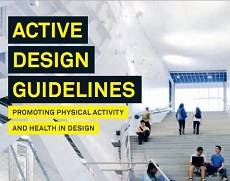July 22, 2013
Active Building Design initiatives announced by New York Mayor
The Mayor of New York Michael Bloomburg has announced a series of initiatives to promote physical activity through the design of buildings and public spaces to encourage architects, planners and urban designers help combat obesity in the City. The Center for Active Design, a non-profit organization that promotes changes to the built environment to improve wellness is being created, and the Mayor has issued an Executive Order requiring City agencies use active design strategies when performing new construction and major renovation projects. Two pieces of legislation will promote stairway access in all buildings, with measures such as making stairways more visible to encourage use.
The Executive Order requires City agencies to review the design of construction and major renovation projects to assess opportunities to implement active design elements. This requirement applies to the construction or renovation of City buildings and streets. The Order also requires that agencies assess opportunities to promote the use of stairways, and that agencies train design and construction personnel in the use of the City’s Active Design Guidelines.
Additionally, the Bloomberg Administration plans to submit for City Council approval two items of legislation to promote access to stairways in all new construction and buildings undergoing major renovations in New York City. The first bill requires that building owners give occupants access to at least one, clearly identified stairway in the building; and post signs that prompt stair use near elevators. The second bill increases access to and the visibility of stairways by permitting the use of hold-open devices in the doors of one stairway per building, for a maximum of three consecutive floors. (Hold-open devices automatically shut in emergencies.)
“New York City has been a leader when it comes to promoting healthier eating and now we’re leading when it comes to encouraging physical activity as well,” said Mayor Bloomberg. “Physical activity and healthy eating are the two most important factors in reducing obesity and these steps are part of our ongoing commitment to fighting this epidemic.”
“For years, architects and planners have been making it easier for people to be sedentary, compounding the nation’s obesity problem,” said Department of Design and Construction Commissioner David Burney. “The active design movement asks design professionals to be part of the solution and find new ways to encourage movement, both in buildings and on the streets. The benefits of active design can be profound: just two minutes of stair climbing a day – rather than using an elevator – can help prevent annual weight gain.”
In 2010, a collaboration of City agencies, not-for-profit organizations, architects, developers, and academic partners worked to develop a manual of strategies for creating healthier communities. Using the latest academic research and best practices, this work culminated in the Active Design Guidelines, which can be accessed here.
David Burney was guest speaker last October at the UK’s first Active Design Symposium, hosted by the Design Council. Information on the event can be accessed here.
The Center for Active Design promotes four key concepts of active design to reduce obesity through the design of buildings, streets, and neighbourhoods:
- Active buildings: encouraging greater physical movement within buildings for users and visitors;
- Active transportation: supporting a safe and vibrant environment for pedestrians, cyclists, and transit riders;
- Active recreation: shaping play and activity spaces for people of different ages, interests, and abilities; and
- Improving access to nutritious foods in communities that need them most.
The Center also supports research, provides professional training, and offers technical assistance to help implement active design strategies.













